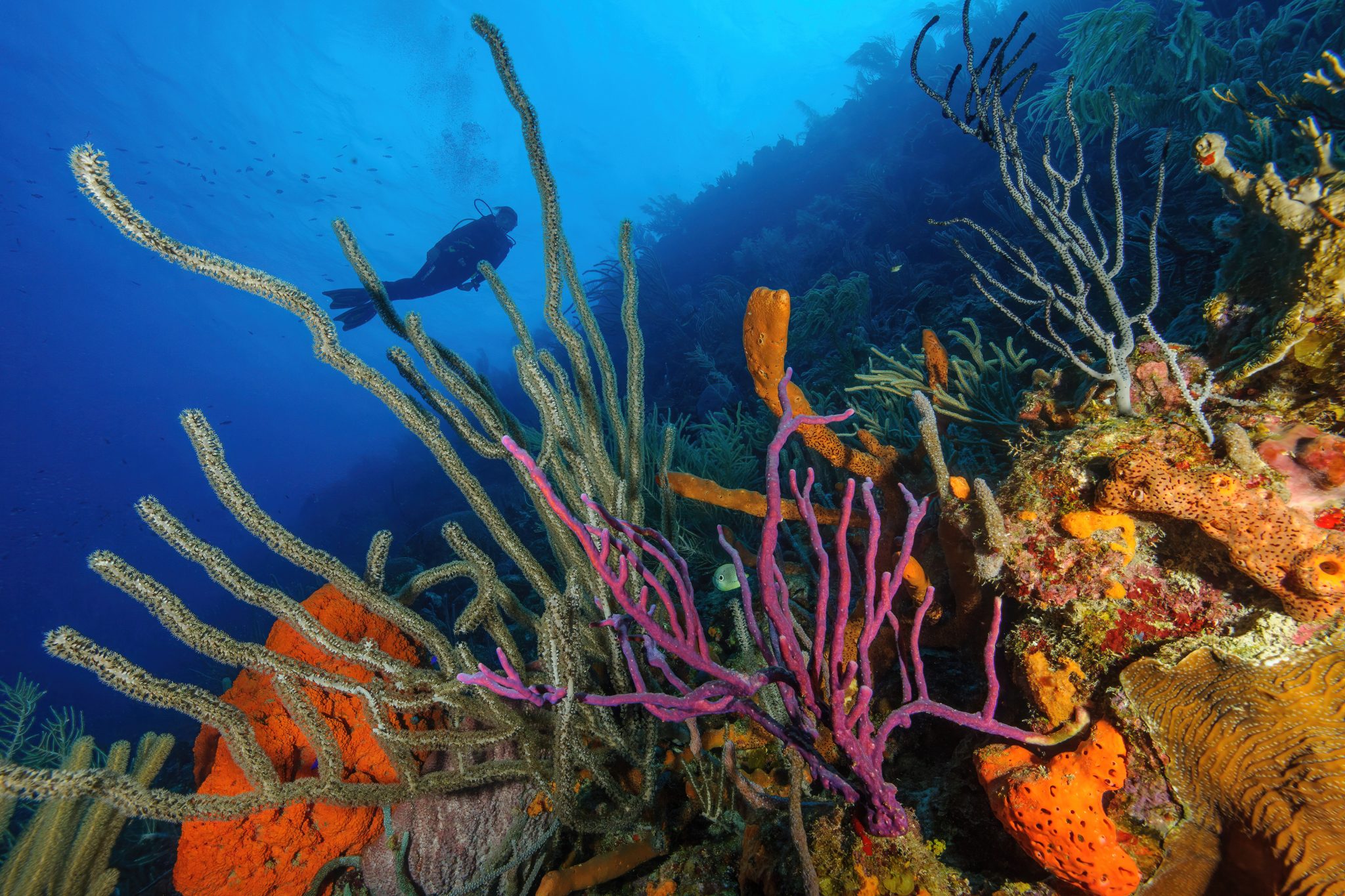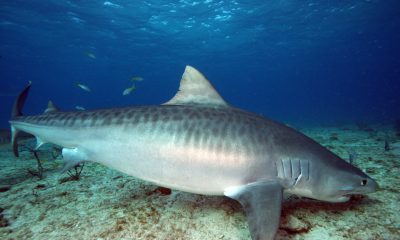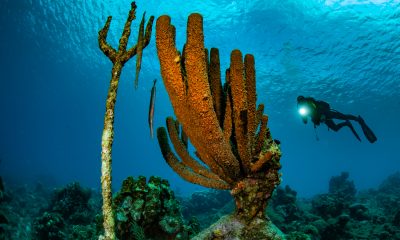Marine Life & Conservation Blogs
Naming and shaming the world’s most ridiculous sharks

Lots of people are frightened of sharks. That makes some sense if you think all sharks are relentless man-eating teeth-machines, but in reality the vast majority of them are much more scared of us, or they should be. There are over 350 species of sharks around the world, but they don’t all get to grab the headlines or star in feature film franchises. Here’s a quick guide to the silliest-named sharks in our oceans.
First up, have to be the Wobbegongs. These bottom-dwelling sharks often end up as the fish in Australian fish and chips, and they characteristically have strongly-patterned bodies and weird wobbly knobbly tassels. That makes them look a bit beardy-weirdy. But I’m sure you’ll agree that it’s hard to be too fearful of a Tassled wobbegong, or the ferocious sounding Floral-banded wobbegong.
Keeping up with the bottom dwelling sharks, next up is the demonic sounding Ginger carpetshark. Carpetsharks are so-called because they have patterns that, er, look like carpets. It’s a bit busy for me, but I guess people have different tastes.
Catsharks are a whole subfamily of shark species; presumably they are called kittensharks when they are little. Ramping up the ridiculous then is the dodgily-titled Flaccid catshark (someone thought long and hard about that name) and its cousin the Lollipop catshark (I’m not making this up, honestly!).
Then there are lanternsharks, some of the tiniest of all sharks, which glow in the dark. Not to be outdone they have some fine names too, like the Splendid lanternshark, who sounds like a jolly nice chap.
Cookiecutter sharks are a bit more ferocious, biting chunks out of unsuspecting prey, rather than baking biscuits, whilst the Hidden angelshark lurks in the sand to pounce on passers-by.
In the Hammerhead family there is the Scoophead (handy for ice cream) and the Scalloped bonnethead (handy for period dramas).
The Porbeagle confusingly is not a cross between a porpoise and a beagle, but a cousin to the Great White. And the Gummy shark confusingly does have teeth, but arguably sounds more like a confectionary creation.
And the Slender weasel shark and Flapnose houndshark really need a rebrand.
My own particular favourite though, dredged up in my trawl of shark species, is the bizarrely titled Sulu gollumshark, a name that honours both Star Trek and Lord of the Rings: Oh my, it’s precious! It also generates a very geeky image of whoever dreamed up the name.
So sharks don’t just deserve our fear and loathing, they also need to be loved and understood. They generally have much more to fear from us than we do from them. Along with the many other despicable things we do to the world’s shark species, we don’t have to give them embarrassingly-stupid names.
Willie Mackenzie is an Oceans Campaigner at Greenpeace UK. www.greenpeace.org
Marine Life & Conservation Blogs
Creature Feature: Undulate Ray

 In this series, the Shark Trust will be sharing amazing facts about different species of sharks and what you can do to help protect them.
In this series, the Shark Trust will be sharing amazing facts about different species of sharks and what you can do to help protect them.
This month we’re looking at the Undulate Ray. Easily identified by its beautiful, ornate pattern, the Undulate Ray gets its name from the undulating patterns of lines and spots on its dorsal side.
This skate is usually found on sandy or muddy sea floors, down to about 200 m deep, although it is more commonly found shallower. They can grow up to 90 cm total length. Depending on the size of the individual, their diet can range from shrimps to crabs.
Although sometimes called the Undulate Ray, this is actually a species of skate, meaning that, as all true skates do, they lay eggs. The eggs are contained in keratin eggcases – the same material that our hair and nails are made up of! These eggcases are also commonly called mermaid’s purses and can be found washed up on beaches all around the UK. If you find one, be sure to take a picture and upload your find to the Great Eggcase Hunt – the Shark Trust’s flagship citizen science project.
It is worth noting that on the south coasts, these eggcases can be confused with those of the Spotted Ray, especially as they look very similar and the ranges overlap, so we sometimes informally refer to them as ‘Spundulates’.
Scientific Name: Raja undulata
Family: Rajidae
Maximum Size: 90cm (total length)
Diet: shrimps and crabs
Distribution: found around the eastern Atlantic and in the Mediterranean Sea.
Habitat: shelf waters down to 200m deep.
Conservation Status : As a commercially exploited species, the Undulate Ray is a recovering species in some areas. The good thing is that they have some of the most comprehensive management measures of almost any elasmobranch species, with both minimum and maximum landing sizes as well as a closed season. Additionally, targeting is entirely prohibited in some areas. They are also often caught as bycatch in various fisheries – in some areas they can be landed whilst in others they must be discarded.
IUCN Red List Status: Endangered
For more great shark information and conservation visit the Shark Trust Website
Image Credits: Banner – Sheila Openshaw; Illustration – Marc Dando
Blogs
Guarding Against Coral Invaders

Protecting (Dutch) Caribbean Reefs from Unomia stolonifera
Recent reports highlight the concerning spread of the invasive soft coral, Unomia stolonifera, currently devastating Venezuela’s marine ecosystems and detected in Cuba. With the potential threat of its expansion to the (Dutch) Caribbean islands, urgent action and awareness are essential to safeguard marine biodiversity and local economies from possible catastrophic consequences.
Invasive species are animals or plants from another region of the world that don’t belong in their new environment. These species can have major ecological effects by decimating native flora or fauna. They can also cause large economic losses and impact human health. Invasive species also pose a significant threat to marine ecosystems worldwide, including the Dutch Caribbean. Among these invaders is the octocoral species Unomia stolonifera or “Pulsing Xenia”, originally from the Indo-Pacific. With its rapid growth and lack of natural predators, this species can outcompete native species and disrupt fragile marine habitats such as seagrass beds and coral reefs.
Background
The invasive soft coral U. stolonifera was first identified in 2014, off the coast of Venezuela. It is believed to have been introduced via the illegal aquarium trade. Since this species can reproduce sexually and asexually (or fragment), even small pieces can regenerate to spread. Once introduced it quickly took over shallow reefs and hard substrate at depths of 0-50 meters, outcompeting local corals and seagrass for space. Follow on surveys found that this coral species exhibited average percentage cover as high as 80%, vastly outcompeting native corals. In highly colonized areas, fish are disappearing due to loss of habitats.
In 2022, during a survey conducted in Cuba by the University of Havana, an unknown octocoral was discovered which was later identified as the invasive Unomia stolonifera. It is suspected that the coral larvae arrived in ballast water from fossil fuel ships originating from Venezuela, as nearby sites adjacent to Venezuelan ports have been heavily affected by the invasion.
How to help
Prevention through continuous monitoring, particularly in high-risk areas such as marine harbors and oil facilities, is paramount. Early detection plays a pivotal role in mitigating the threat posed by Unomia stolonifera.
The public’s involvement and awareness are also vital. Local communities, recreational divers, tourists, and all stakeholders are urged to participate in early detection efforts by reporting sightings (photo, location and date) of this invasive coral to their respective Protected Area Management Organization (PMO’s)- the Fundacion Parke Nacional Aruba (FPNA), STINAPA Bonaire, CARMABI Curaçao , Saba Conservation Foundation (SCF), Nature Foundation St. Maarten (NFSXM) and St. Eustatius National Parks (STENAPA). If an invaded area is confirmed, follow the recommendations by the local PMO’s.
Keys to Success
Despite the challenges, early detection is key to mitigating the threat posed by Unomia stolonifera. With continued vigilance, research, and community engagement, there is hope for containing this potential issue before it becomes a major threat.
About the DCNA
The Dutch Caribbean Nature Alliance (DCNA) supports (science) communication and outreach in the Dutch Caribbean region by making nature related (scientific) information more widely available through amongst others the Dutch Caribbean Biodiversity Database, DCNA’s news platform BioNews and through the press. This article contains the results from several scientific studies but the studies themselves are not DCNA studies. No rights can be derived from the content. DCNA is not liable for the content and the in(direct) impacts resulting from publishing this article.
-

 News3 months ago
News3 months agoHone your underwater photography skills with Alphamarine Photography at Red Sea Diving Safari in March
-

 News2 months ago
News2 months agoCapturing Critters in Lembeh Underwater Photography Workshop 2024: Event Roundup
-

 Marine Life & Conservation Blogs2 months ago
Marine Life & Conservation Blogs2 months agoCreature Feature: Swell Sharks
-

 Blogs1 month ago
Blogs1 month agoMurex Resorts: Passport to Paradise!
-

 Gear News3 months ago
Gear News3 months agoBare X-Mission Drysuit: Ideal for Both Technical and Recreational Divers
-

 Blogs2 months ago
Blogs2 months agoDiver Discovering Whale Skeletons Beneath Ice Judged World’s Best Underwater Photograph
-

 Gear Reviews2 months ago
Gear Reviews2 months agoGear Review: Oceanic+ Dive Housing for iPhone
-

 Blogs3 months ago
Blogs3 months agoThe Thrilling Encounter with Tiger Sharks at Beqa Lagoon’s ‘The Colosseum’ with Coral Coast Divers




















